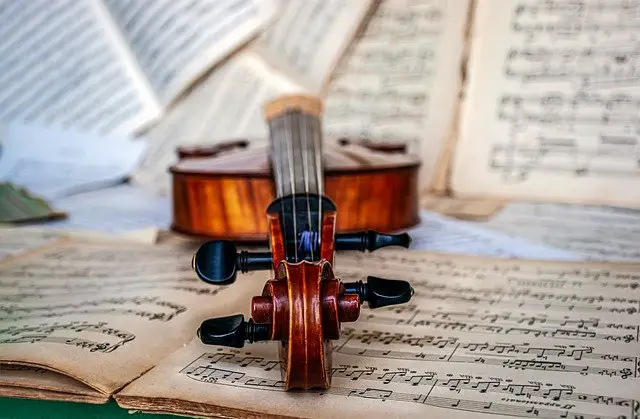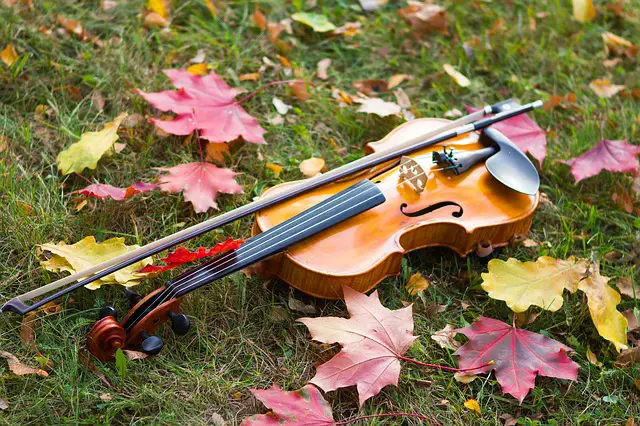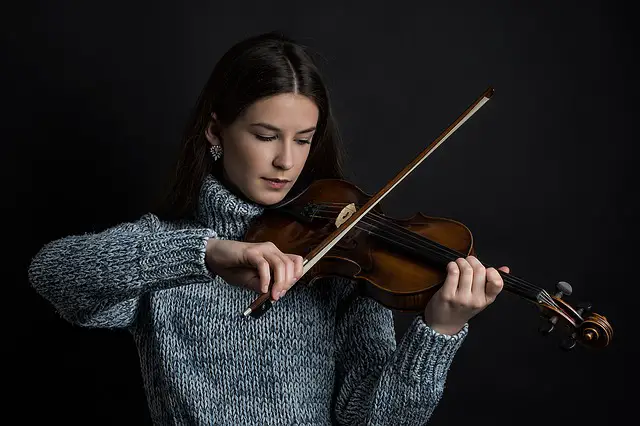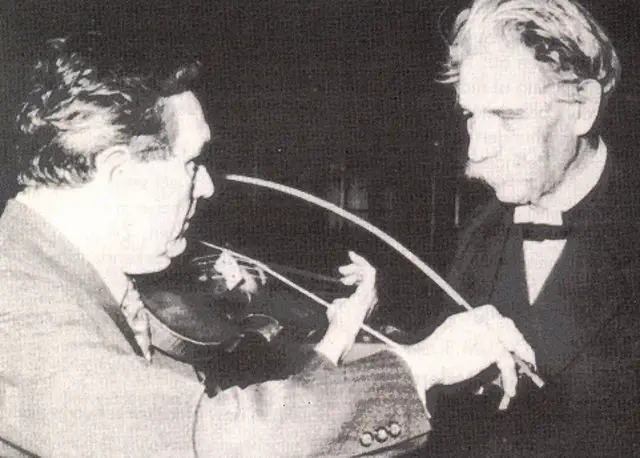
History of the Violin Bow And How It Evolved
The structure of violin bows, like that of the violin, has evolved over time – that’s why we’re written this whole article about the history of violin bows.
But did you know though that the first bows were made during the Byzantine Empire in the mid-fifth century. These ancient bows were convex in the same way that archery bows are.
Initially, they were crudely constructed, with the horsehair tied directly to the pole with no regard for tension.
Prior to the Baroque era, the frog was a curved piece of wood attached to the bow that merely served as a rail to direct the hair and keep it apart from the stick. While playing, the thumb was used to apply tension to the bow.
These simple bows remained unchanged throughout the Middle Ages. Because the violin had not yet been invented, these bows were employed to play antique instruments such as the rebec and the medieval fiddle or vielle. Instruments were regarded to be less essential than singing during the beginning of the 16th century.
These violin predecessors were primarily used as rhythm instruments to accompany vocal music and to keep time for dancing at festivities and weddings. Bows of the time were short, measuring approximately 20 to 30 centimeters in length. They were held in a very different way than the modern bow, with either a closed fist or an underhanded approach.
Contents
The Baroque Bow
During the Baroque period, playing techniques evolved more, and the bow’s construction required to adapt to better control. Initially, early violin virtuosi continued to use the late-medieval rebec and vielle bows. Because early French Baroque music was similar in style to Renaissance dance music, bow construction and technique differed slightly.
German Baroque music, which was more introspective and had a slower rhythm, was also still performed with strongly arched bows. The string player was frequently required to produce correct chords in the music. To release the tension, the thumb was used to change the tension of the bow hair, and two or more strings may be played in a chord.
The single melodic lines were then given a tighter tension. Today, music written as chords, such as Bach’s solo sonatas and partitas for violin, is played as arpeggios. An arching bow, on the other hand, might be used to play true chords in a historically informed performance.
The violin of the Baroque period evolved in Italy for two reasons. In comparison to German Baroque music, Italian Baroque music demanded quickness and rapidity while remaining light and airy.
In contrast, in early French music, the violin was no longer merely employed to keep time for dancing; it had evolved into a solo instrument. Cantabile, or songlike, playing piqued the Italians’ curiosity. Italian violinists preferred an overhand grip and larger bows, which enabled them to experiment with new sounds and approaches.
Longer bows allowed for longer sequences, and spiccato and legato became increasingly popular. Arcangelo Corelli (1653-1713), in addition to being a composer, was a violinist who had a significant influence on technique and instructing.
He wrote violin pieces that called for the long Baroque violin bow. As a result, Corelli’s compositions made violin music sound like singing. Construction changes were done to accommodate the longer Baroque bow. The height of the head was raised to more equally distribute weight and improve playability along the entire length of the bow.
The bow’s convex shape shrank until it evolved into a bow that was somewhat straight to concave. A removable frog was designed to improve hair tension until the button, eyelet, and screw system became standard. Bows were artistically elegant at the time. They might be carved with fluting and were made of magnificent wood such as snakewood, ironwood, and china wood.
Corelli bows were shorter and lighter than modern bows, especially at the tip. Furthermore, the balance point is closer to the frog, the hair gives more, and the ribbon of hair is just 6mm against 12mm.
The Classical Bow
By the end of the 18th century, the bow had transformed once more. The music itself, like in the Baroque era, provided the inspiration for this. Many more solo violin works were being written. To manage enormous settings like the performance hall and the accompaniment of symphonic orchestras, the violin’s sound had to grow more forceful.
Virtuosi gained popularity in the musical world at the time. This predisposition corresponded to a growing interest in the concept of genius. These virtuosi were known for their multifaceted bowing technique. The bow’s design had to be flexible enough to accommodate more powerful compositions. The bow was modified to increase its breaking strength.
Transitional bows were popular during the Classical era. Between the Corelli-Tartini model and the invention of the Tourte bow, the “Cramer bow” (named after violinist Wilhelm Cramer) was preferred by the main violin soloists. The “Cramer bow” included a hammer-shaped head, a clip-in frog, and a solid concave stick.
This bow’s hair ribbon was broader than the Corelli model bow but still narrow in contrast to a Tourte bow. In other bow evolution news, John Dodd (1752-1839) invented a new method of splitting wood that boosted the breaking strength of the stick. Christian Wilhelm Knopf’s development of metal under slide eliminated a major weak point in the screw mechanism of the Baroque bow.
Francois Tourte
Francois Tourte began working on the manufacture of violin bows between 1785 and 1790. Tourte was responsible for several of the modern bow’s attributes. He collaborated with the legendary violin virtuoso Giovanni Battista Viotti to modify the bow’s design and structure. Torte employed mathematics to determine the ideal bow proportions.
Toure widened the bow. In the tip, he used additional wood, which was balanced by a heavier nut. As a result, the bow was heavier than the Baroque version, and the bow was carved to the correct shape before Tourte began working on it. This made little difference to the hair’s tension. Torte employed heat to bend Pernambuco wood, giving the stick a more exact tension.
He invented the winding mechanism that tightens the bow, as well as the spreader block, which keeps the hair in a flat ribbon and prevents tangling.
A Tourte bow’s hair ribbon was wider than a Corelli bow’s. Tourte saw the frog as a valuable object and fashioned his frogs from ebony, gold, and tortoise shell. He also standardized frog decoration and covered the mechanisms with a pearl underslide and a pearl “eye” inlay on either side.
Tourte’s bows were perfectly balanced, with a rapid and nimble response thanks to a strong concave arch. His bows gave him more dynamic and projected range.
After Tourte
Ebony became the standard material for bowmakers (or archetiers) who followed Tourte. Tourte’s version was enhanced by Francois Lupot, who added a copper underslide to reinforce the frog’s brittle ebony edges and increase stability.
Jacques LaFleur created a method for attaching hair that replaced the traditional mortise, plug, and wedge (1757-1853). When the violinist applied more pressure, Jean-Baptiste Vuillaume used an oval ferrule, which broadened and flattened the hair ribbon.
Throughout the early twentieth century, tortoiseshell and ivory were used to embellish frogs. The Convention on International Trade in Endangered Species finally controlled the use of tortoiseshell and ivory. If ivory is used now, it is derived from fossil ivory.
Since Tourte perfected the violin bow, nothing really has changed. Aside from the usage of composite materials, there have been few recent advancements in bow manufacture. Fiberglass bows originally appeared in the 1960s, while carbon fiber bows began to be produced in the 1990s.
Previously, these composite bows were inexpensive student versions, but some of the higher-quality carbon fiber bows are comparable to fine Pernambuco sticks. Because of a scarcity of fine Pernambuco, composite bows have become more popular. Unfortunately, agricultural expansion has encroached on the areas of Brazil where Caesalpinia echinata is grown.
Violin Bow FAQ’s
When did the violin bow first appear?
It was created around the year 1700 and is attributed to Stradivari. As the 19th century progressed into the Transitional period, the separation of hair from stick got larger, particularly at the crown.
When did the violin bow go through a transformation?
The bow began to change with the advent of the modern violin in the 17th century. Adjusting hair tension piqued people’s curiosity, and efforts were made to mechanize the process.
Why is the violin bow referred to as a frog?
The frog is actually a component of the bow of the violin (or viola, cello, bass, or gamba). However, the exact origin of the phrase is unknown.
- Viola vs Violin – 5 Key Differences Between The Two Instruments - March 20, 2024
- 15 of the Most Famous Violinists of All Time (18th Century to Present) - March 20, 2024
- Full School Band Instruments List (Elementary / Middle / High) - March 18, 2024



